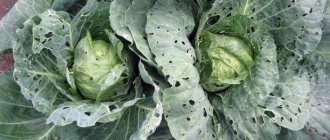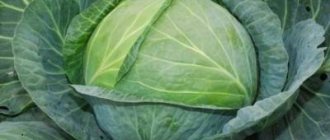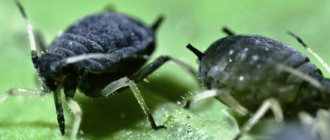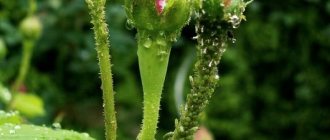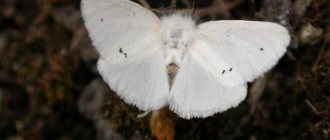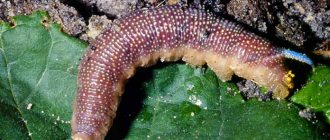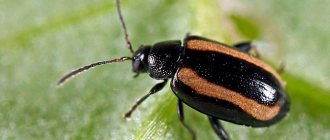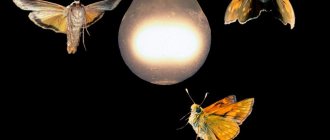Juicy soft cabbage leaves attract insects as an accessible source of food - the tender pulp is easy to bite through and contains many nutrients. The most common pest is the caterpillar, which develops quickly and can destroy the plant in a short time, leaving only hard veins of the leaves. There are several ways to get rid of it, the choice depends on the stage of development of the insect, its number, and planting area.
What caterpillars and butterflies parasitize cabbage?
Caterpillars and butterflies are most often found in cabbage beds. These pests feed on plant leaves, causing the cabbage to begin to wilt.
Whitefly
A whitefly is a butterfly with white wings edged with a black stripe. The lower wing is usually yellowish. You can also notice a black dot on the wings. The butterfly is not very large in size.
The whitefly lays eggs on the underside of cabbage leaves in May. The butterflies themselves do not cause any harm to the cabbage; only the hatched whitefly larvae cause damage. After hatching, the caterpillars crawl to the outside of the leaves and feed on them. The appearance of caterpillars in the beds leads to a delay in the development of cabbage seedlings. The whitefly reproduces very quickly, and three generations of insects can be replaced in one summer.
scoop
The cutworm is a small moth that is predominantly nocturnal. The pest is gray in color; cutworm larvae are green-brown. Moths lay eggs on plants. And after the larvae hatch, they feed on cabbage leaves, thereby causing damage to the entire crop. Cabbage cannot develop normally and begins to wither.
Green caterpillar
Another pest that is often found in cabbage beds is the green caterpillar. The eggs, from which green caterpillars then emerge, are laid by the cabbage moth. The pest appears in the beds at the end of April and lives on cabbage until July. Over time, the green caterpillar can cause serious damage to the crop if you do not start to fight it.
How to detect
Neglecting regular inspection of fruits is one of the worst sins of a vegetable grower. An apparently healthy fetus can turn out to be a real “Trojan horse.” As soon as you remove several layers of leaves from such a head of cabbage, your eyes will appear swarming with larvae.
Catching lesions as early as possible is extremely important. Experienced farmers name the following factors as the first signs:
- Small holes began to appear . At first, the perforation is barely noticeable. It starts from the bottom and gradually rises, the size of the holes increases. Heavy infestation is characterized by almost continuous large holes.
- The leaves are covered with mucus . When moving, caterpillars leave slimy trails behind them.
- Moves have appeared on the heads of cabbage and the edges of the leaves have been eaten away . Most often these are the consequences of the cutworm, which is how it chews its way through.
- Excrement is visible. They look like small brown and black specks.
- The vegetable began to rot right in the garden . Waste products provoke putrefactive processes.
- The growth of the head of cabbage has stopped, the leaves are sluggish and thin . The new residents are drawing vitality from the cabbage.
Any of these signs, especially their combination, is a warning sign. In addition, you need to inspect the cabbage for the individuals themselves. At night they crawl out onto the leaves; during the day you have to look closer to the stalk.
Other vegetables also suffer from cabbage caterpillars. Carrots, beets, zucchini, other crops. In advanced cases, even flowers and fruit trees are affected.
Signs of cabbage damage
A characteristic sign that pests are appearing on the bushes is the presence of holes and gnawed leaves. It can also be noted that the seedlings begin to grow poorly and stop developing. If large heads of cabbage appear, you can see holes in them, and if you open such a head of cabbage, there may be larvae there.
If you examine the bushes, you will notice the appearance of eggs on the cabbage leaves. They are usually located on the inside of the leaf. You can also pay attention to the fact that if butterflies or moths often fly near the beds, then most likely, after some time, larvae will appear on the seedlings.
Soda
This product is inexpensive and does not require special skills to prepare. For 5 liters of warm water you need to take 100 g of baking soda. Dissolve the powder in the liquid and mix thoroughly. Make sure that there is no soda residue left at the bottom of the container. After preparation, the solution must be used immediately. The resulting liquid is used to treat cabbage heads.
Baking soda can also be used in dry form. You need to mix 100 g of baking soda and 100 g of any flour. Treat the plant bushes with the resulting mixture. The powder is safe for people and pets, but is lethal to caterpillars.
What harm is done to vegetable crops?
The butterflies themselves do not pose a threat to cabbage. Damage to the crop is caused by larvae, which the pests lay on the foliage. After the larvae hatch, they begin to eat the succulent young leaves. Because of this, the seedlings stop developing and may die completely.
If the larvae appear on formed heads of cabbage, they gnaw through them. Subsequently, the cabbage withers and disappears.
If there are a lot of larvae, they are able to gnaw out entire heads of cabbage. Naturally, after this the head of cabbage can be thrown away. Over the summer, if pests are not controlled, they can multiply so much that they destroy not only the cabbage crop, but also other agricultural crops.
Chemicals
The use of products containing chemically active substances is a fairly powerful weapon against caterpillars. They die quickly and in large numbers. Therefore, some farmers still use them.
There are many industrial products available for chemical warfare against caterpillars and other pests.
Here are just a few of them:
- Triflurex - solution is prepared at the rate of 240 grams per liter of water.
- Butizan - 400 grams per liter of water.
- Splender - 25 grams per liter of water.
- Decis Extra – 125 grams per liter of water.
When using insecticides, a person must wear a special mask, rubber gloves, and clothing made of thick fabric. The solution should be sprayed at a time when there is no rain or wind. Before using a chemical, you must carefully read the instructions. It is important to obtain accurate knowledge about the timing, volume and frequency of processing.
Use chemicals only in special cases when other methods of exterminating caterpillars have not worked. Such drugs are poisonous. They affect not only pests, but also penetrate plant cells, and through them into the human body.
Benefits of using chemical-free products
Unlike aggressive chemicals, which are often used to kill pests on the site, folk remedies are not toxic and are not absorbed into plant tissue.
Traditional methods are safe and can be used even when the harvest is almost ripe.
We save the cabbage harvest using folk methods in any growing season. The same cannot be said about the use of chemicals. They can be used only in the early stages of growth, when the heads of cabbage have not yet formed. Although chemicals are more effective, especially if the pest population is very large. Folk remedies help cope when there are not very many caterpillars and butterflies on cabbage.
Ammonia
Strong odors scare caterpillars away from cabbage, forcing them to look for a more pleasant-smelling delicacy. To prepare the infusion you will need ammonia. The product is diluted in a ratio of 1 to 5 with water and sprayed on plants affected by pests. The method will also be effective as a preventive measure. But it should be remembered that frequent use of alcohol can have a negative effect on plants by drying out the leaves.
3 ways to increase potato yield by a couple of kilograms per bush
Traditional methods of fighting caterpillars
What to do if insects appear on cabbage and destroy the crop, how to get rid of pests without harming the crop. There are many effective and yet safe methods for controlling insects in cabbage beds.
Sugar solution
Treating the crop with a sugar solution is used to attract wasps to the area. Caterpillars are afraid of wasps because they feed on larvae and eggs. To prepare a sugar solution, you need to take 2 liters of warm water and add 500 g of sugar to it. You can also use old jam. Stir thoroughly to form a sugar syrup and sprinkle over the cabbage heads. The sweet smell will attract wasps, and they, in turn, will destroy the larvae and eggs of cabbage pests.
See also
20 best varieties of Chinese cabbage with descriptions and characteristics
Read
Chicken eggs
A very original way to get rid of white butterfly on cabbage is to use chicken eggs, or rather, egg shells. Among the cabbage beds, wooden stakes are driven into the soil, and halves of egg shells are hung on them. You can only use white shells; brown eggs are not suitable for this method.
Butterflies mistake white shells for their relatives and do not lay eggs, believing that the place is already occupied.
Tomato tops
The white butterfly searches for its favorite vegetable by smell, so if you kill the smell of cabbage, you can prevent the appearance of caterpillars in the beds. A decoction of tomato tops is suitable for this. Butterflies cannot tolerate the smell of tomatoes and will not lay eggs if they smell it.
Tomato tops are poured with 3 liters of water and put on fire. Bring the broth to a boil and remove from heat. Let the broth cool. To make the decoction stick better to the leaves after processing, grated shavings of laundry soap are added to it. Spraying is best done after sunset. It is also worth checking the weather forecast to ensure there is no rain in the coming days.
Soda solution
Another effective remedy for butterflies and caterpillars on cabbage is spraying with a soda solution. Half a pack of soda is diluted in 5 liters of water and poured into a spray bottle. Spray the heads of cabbage with the solution after sunset and watering. Instead of a solution, you can sprinkle soda on the foliage and leave it like that for several days. The main thing is that it doesn’t rain in the coming days and wash away the soda.
Ash infusion
Ash infusion is very effective against caterpillars. Wood ash is diluted in water and allowed to brew for 24 hours. The more ash you add, the more effective the product will be. Add 5 tbsp to the finished infusion. l. tar soap. Then the cabbage beds are sprayed with the resulting infusion.
Black pepper decoction
A decoction of black pepper will help get rid of caterpillars on cabbage. A package of black peppercorns is filled with 2 liters of water and put on fire. Boil the broth for 15 minutes. Then let it brew under a closed lid for 2-3 days. Before watering, the broth is diluted in water and shavings of laundry soap are added. Water the beds with the resulting decoction every 2 days.
Mustard and vinegar
You can pickle cabbage using mustard powder and vinegar. 50 g of mustard are diluted in water, then infused for 3 days in a dark room. Before spraying, the infusion is filtered through cheesecloth. Water the resulting mustard infusion over the beds along with the foliage. This product helps to cope not only with caterpillars, but also with slugs. Spraying the bushes with vinegar diluted in water is also effective. 4 tbsp. l. vinegar is diluted in 4 liters of water and the plants are treated.
Valerian infusion
White butterflies cannot tolerate the smell of valerian, so they do not lay eggs where this plant grows.
How to prepare a decoction of valerian to repel whites:
- Cut off the leaves and stems of the plant, finely chop the roots.
- Fill with water and put on fire.
- Boil for 10 minutes.
- When the broth is ready, cover it with a lid and let it brew for 24 hours.
- Water the beds with infusion from a regular watering can.
You need to water cabbage with valerian several times a week after sunset. Valerian can also be planted in a plot next to some crops. This plant has a very strong smell that repels insects from the area.
Hot pepper decoction
A decoction of hot pepper can be quite effective against caterpillars on cabbage. Several pieces of hot pepper are crushed, poured with water and put on fire. Bring to a boil. After this, cool the broth and, before spraying the beds, strain it through cheesecloth.
Burdock infusion
A decoction of burdock leaves will help get rid of caterpillars on cabbage. The leaves contain substances that act as poison on caterpillars. To prepare the infusion, fresh burdock leaves are cut and crushed. Then fill with water. Infuse burdock infusion for two days. Before spraying the cabbage, filter it and add water.
Infusion of burdock and garlic
An infusion of burdock and garlic will help destroy caterpillars on cabbage. Chop burdock and garlic leaves and add 3 liters of water. Insist for 2 days. Before watering, dilute with warm water.
Another way to prepare an infusion is to add tar soap to it. Grind the green parts of the plants and fill them with water. Leave to ferment for 2 days. Before spraying the plants, add 70 ml of tar soap. To stir thoroughly. Treat cabbage every three days until the caterpillars disappear from the area.
See also
What to do if ants eat cabbage, and what are the best ways to get rid of it?
Read
Tobacco dust
40 g of tobacco dust is poured into 3 liters of water. They insist for three days. Before processing, cabbage is diluted with water and laundry or tar soap is added. Another way is to grow smoking tobacco in your garden, cut off the leaves as they grow, and dry them. Grind, and in the spring after transplanting the seedlings into open ground, sprinkle with tobacco. The unpleasant smell of tobacco will scare off butterflies, and they will not lay eggs on seedlings.
Soap-ash infusion
To prepare a soap-ash solution you will need 500 g of ash, 100 g of grated laundry soap and 4 liters of water. Dilute all ingredients in water and let it brew for 24 hours. Spray cabbage every 3 days in the evenings.
Tansy flower powder
Tansy inflorescences are cut off and laid out in a dark room to dry. When the flowers are dry, they are ground into flour. The resulting tansy powder is used to dust the beds. Tansy has a specific smell that repels insects. Foliage can also be used along with the inflorescences.
Why do they appear?
As a rule, gardeners themselves provoke the appearance of cabbage pests by improperly caring for the site.
Novice vegetable growers make mistakes especially often, but even experienced ones sometimes make the following mistakes:
- improper application of fertilizers;
- violation of crop rotation norms;
- improper soil cultivation for wintering and sowing;
- ignoring prevention;
- lack of quarantine for newly acquired plants.
Expert opinion
Mityuk Stefania Bogdanovna
It is better not to eat heavily affected fruits. Caterpillar poisons can severely poison vegetables.
It is extremely difficult to get rid of a pest if small butterflies have already begun to fly over the garden bed. If adult moths are circling over the garden, immediate treatment is necessary to prevent them from laying eggs.
Fighting scoop and cabbage
Another pests that often have to be dealt with are cutworms and cabbageweeds. You can also get rid of these pests using folk remedies.
Pepper
Pour water over ground black pepper and boil for 10 minutes. Strain and let cool to room temperature. Spray the cabbage with the broth after sunset. You can also use peppercorns. You can add onion skins to the black pepper decoction and boil with it.
Sagebrush
Pour water over wormwood leaves and leave for 24 hours. Spray the bushes 3 times a week. Another way is to scatter cut wormwood bushes over the area with cabbage. As soon as the branches begin to dry out, they are replaced with fresh ones. Wormwood can be scattered around the site until harvest. Wormwood has an unpleasant odor for butterflies, so they try to avoid it.
Litter
Watering with chicken droppings also repel armyworms. Dilute rotted chicken manure in warm water. Mix thoroughly and pour the resulting solution over the cabbage. Only rotted chicken manure should be used; fresh chicken manure is too concentrated and can burn all the cabbage roots.
Pheromone traps
Pheromone traps are a triangular container containing adhesive tape and pheromones that attract insects. Pests crawl inside and stick to the tape. This method is quite effective and safe for the crop. Pheromone traps can be purchased at gardening stores or made yourself.
To do this, you need to put together a triangular shape from the boards, before attaching adhesive fly tape to the bottom part. Set a trap in the cabbage beds.
Biological methods
Biological methods involve attracting birds and insects to the site that feed on pests. The only disadvantage of this method is that it is not the most effective and does not always help get rid of pests.
Wasps, ants and hornets
You can destroy butterflies and caterpillars on cabbage by attracting wasps, hornets and ants to the area. These insects feed on caterpillars. To do this, you can spray the bushes with sugar, honey or jam diluted in water. The sweet smell attracts insects to the cabbage, which in turn feed on the larvae that eat the leaves.
Birds and insects
Birds also love to feast on caterpillars. To attract birds, you can plant rowan on the site. Or scatter bread crumbs or seeds in the garden bed. You can also hang a feeder nearby. Many insects can be attracted to the site if you spray the beds with a sugar solution. You can resort to this method together with spraying cabbage with decoctions and infusions to destroy pests in the area.
Spices
Planting herbs among the cabbage beds will help save space on the site and at the same time prevent the appearance of insects. Most pests cannot tolerate the smell of herbs and inflorescences.
Herbs that repel pests:
- marigold;
- dill;
- garlic;
- tomatoes;
- borage;
- mint;
- sagebrush;
- tansy.
The only disadvantage of planting herbs is that it is the most ineffective way to protect against pests.
Prevention
Problems with tracks can often be avoided through simple manipulations.
After each harvest, it is recommended to thoroughly clean the beds, remove all debris, leaves, and root debris. At the same time, all weeds near the garden are removed. It is better to burn waste so as not to create unnecessary rot. Cruciferous weeds (colts, shepherd's purse, etc.) should be weeded especially carefully.
Before sowing, it helps to dig up the soil to a depth of about 15 cm and use agrofibres. The same should be done if the soil dries out too much. Caterpillars often hide in cracks. A week before planting, the soil is treated with a pink solution of potassium permanganate. This procedure will kill the pupae that survived the winter.
Regular site cleaning includes inspection of plants, collection of rotten parts, weeds, and slight loosening of the soil to destroy caterpillar nests.
During periods of mass butterfly attacks, you can cover the beds with gauze to make it more difficult for insects to lay eggs on the leaves.
Vinegar
This product is recognized as the most effective in the fight against caterpillars. Stir 2.5 tbsp in 5 liters of water. l. essences. Cabbage bushes are treated with liquid from a watering can.
First of all, you should first try traditional methods of pest control: if they do not produce results, then you can move on to professional means. But it should be remembered that insecticides are used only before the formation of forks. It is not recommended to use chemicals at subsequent stages of cabbage growth.
Due to the low cost of the ingredients and the ease of preparing the solution, the following recipes are especially popular:
- 2 cups of 9 percent vinegar per 10 liters of water;
- 2 tbsp. spoons of 70 percent vinegar essence per 10 liters of water.
The resulting mixture should be thoroughly watered over the vegetables, making sure to “grab” the leaves.
There is no need to water cabbage with vinegar in its pure form. 9% table vinegar is very effective against pests, but the acid corrodes not only insect tissue, but also any other organic matter. Too much acetic acid will damage the developing heads of cabbage.
